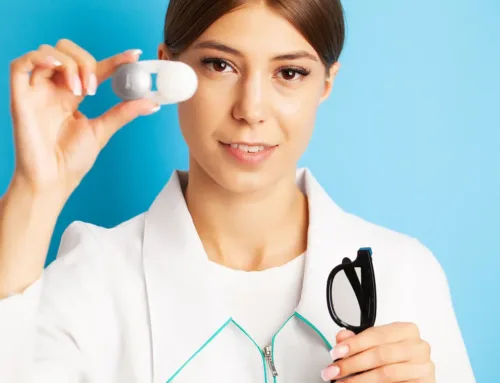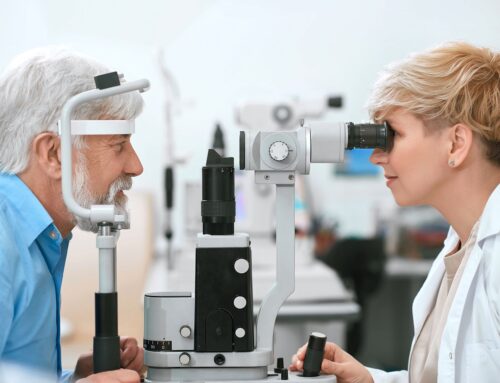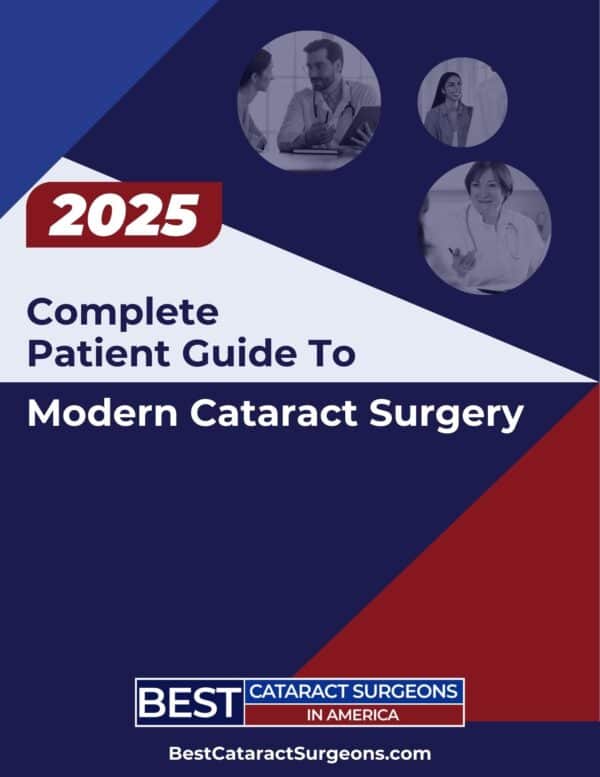Cataract surgery is the most common surgical procedure in the United States. Millions of patients who have cataract surgery every year. After surgery patients are expected to use eye drops.
There are several different types of eye drops. In this article you’ll learn everything you need to know about eye drops after cataract surgery.
As you prepare for your cataract surgery, be sure to discuss which eye drops you should take with your surgeon.
Eye Drops for Cataract Surgery – “The 3 A’s”
There are many different types and brands of eye drops that you could take after cataract surgery. There are 3 main categories of eye drops that just about every patient will need. You can remember these categories as “The 3 A’s” or “Triple A”.
“Triple A” stands for Artificial Tears, Antibiotic, and Anti-Inflammatory.
These drops each serve a different and distinct purpose in your recovery from cataract surgery. Let’s discuss these categories in more detail.
Artificial Tears
Artificial tears are the most common type of eye drop in the world. Virtually everyone has experienced the symptom of irritation or dry eyes at some point.
Artificial tears lubricate the surface of the eye to keep it comfortable.
After cataract surgery there are several reasons that you should expect to have irritation symptoms. For one, there will be a scratch on the surface of your eye from the procedure that can feel scratchy.
Typically the symptoms are mild and last a few days, but they can last longer. The other eye drops can also irritate the surface of the eye.
Most patients should expect to use an artificial tear drop as needed for the first month after surgery. Some will need it longer. Others will need it less. But it’s smart to have a bottle around in case you need it.
We’ll discuss our recommended brands a little later in this article.
Antibiotic
Patients are typically prescribed an antibiotic eye drop after surgery to prevent infection. There are many different antibiotic eye drops on the market. We’ll discuss below some of the most commonly recommended drops below.
Anti-Inflammatory Drops
In addition to preventing infection, you will want to minimize inflammation after your procedure. Anti-inflammatory drops will help you accomplish this task.
There are 2 types of anti-inflammatory drops that you may be prescribed:
1. Steroid Anti-Inflammatory
2. Non-Steroidal Anti-Inflammatory (NSAID)
You may be prescribed one or both of these types of eye drops. Almost all surgeons prescribed steroid eye drops. Many also choose to prescribe NSAID’s to every patient. Ask your surgeon if you have questions about whether you should be on one or both of these drops.
Best Artificial Tear Drops After Cataract Surgery
There are many, many different brands of artificial tears. It’s normal for your eye to feel scratchy and irritated after cataract surgery. There is quite literally a small scratch on the surface of your eye that will heal over the days and weeks after surgery.
The goal of using artificial tears after surgery is to keep your eye comfortable, minimizing symptoms of irritation during your post-operative recovery period.
Therefore, most patients do *not* need any additives in their artificial tears eye drops.
This means you don’t need “get the red out” additives, or anti-allergy additives. You just need a plain artificial tear.
For most patients, this means choosing one that is preservative-free, since preservatives can cause irritation in some patients.
As always, consult with your doctor before putting anything in your eye, including artificial tears.
Antibiotic Drops After Cataract Surgery
There are many different antibiotic eye drops on the market. There is no one drop that is “the best”.
Common antibiotic drops for after cataract surgery are in the fluoroquinolone family. These include drops like moxifloxacin. A commonly used brand name for moxifloxacin eye drops is Vigamox.
There are many different options here. What’s most important is that regardless of which drop you are prescribed… you use it as instructed!
Make sure you are clear about your eye drop instructions for after surgery!
Anti-Inflammatory Drops After Cataract Surgery
After your surgery, your surgeon will likely want you to take anti-inflammatory drops. These drops speed up the healing process and prevent complications that can occur from prolonged inflammation.
Everyone has inflammation after surgery. So it is important to make sure you have these drops, and understand your surgeon’s instructions.
Steroid Anti-Inflammatory Drops
The most common steroid drop is called “prednisolone”. It is available in branded and generic formulations. Prednisolone is one of the most common eye drops in all of eye care.
There are many different regimens of steroid therapy.
Most commonly, you will be asked to take the drop for several weeks, gradually tapering down the frequency of dosing.
For example, you may be asked to take it 4 times per day for the first week, then 3 times the next week, and so on.
Make sure you understand how you are supposed to use this drop after your surgery.
Non-Steroidal Anti-Inflammatory Drops [NSAID]
Non-steroidal anti-inflammatories drops (NSAID’s) are a different type of drop that also reduces inflammation after surgery.
NSAID’s are used in addition to steroids to further reduce inflammation and complications related to inflammation after your surgery.
There are many different types of NSAID’s. The frequency of dosing varies. Some are longer acting, and only need to be dosed once or twice per day. Others are shorter acting, and maybe dosed more frequently.
Common names of NSAID eye drops include:
- Ketorolac
- Bromsite
- Prolensa
- Nepafenac
Discuss with your doctor how often, and for how long, you are supposed to use these eye drops.
How to Administer Eye Drops After Cataract Surgery
Eye drop technique is important. You don’t need to pour the entire bottle in your eye. One drop is plenty. In general, if you feel like your eye got wet, it means you got enough in there.
- The most common technique involves:
- Tilt head back
- Look up towards your eyebrows
- Pull down on lower eyelid
- Put one drop in the “pocket” of the lower eyelid between the eyelashes and the eye
- Blink several times
Some patients have a hard time with drops. Don’t be afraid of asking a friend or family member to help.
Prescription Versus Over-The-Counter
Artificial tears can be purchased over-the-counter. However, the antibiotic and anti-inflammatory drops are prescription only.
Don’t wait until the last minute to get your drops!
You don’t want to be searching pharmacies on the day before your surgery to find the drops that you need. Get your prescriptions filled in advance… and order your artificial tears early.
Best Over The Counter Eye Drops After Cataract Surgery
Artificial tears are the most common over-the-counter (OTC) type of eye drop used after cataract surgery. There are many different brands and generic artificial tears available.
In general, we recommend using branded artificial tears. In recent years, there have been problems with several of the generic artificial tears on the market.
Some of the most trusted brands of artificial tears are:
Discuss which brands your doctor trusts and recommends. You can also search the news to see if there have been any recent recalls for safety or contamination.
What are the Best Drops for Dry Eyes After Cataract Surgery?
Artificial tears are typically the first drop recommended for dry eyes after cataract surgery. Dry or irritated eyes can be common after any eye surgery. This typically goes away with time as the swelling and inflammation from surgery resolve.
The medicated eye drops are important to prevent infection and reduce inflammation, but they can dry your eyes out.
Common brands of artificial tears include Refresh, Systane, and Blink.
Best Eye Drops for Cataracts
Many patients ask what eye drops can be taken to prevent or treat cataracts. Unfortunately, there are no eye drops that are currently FDA approved for the treatment or prevention of cataracts.
If you’re interested in other steps that you can take to prevent cataracts, read our full article on “How to Prevent Cataracts“.
Names of Eye Drops Used After Cataract Surgery
For reference, let’s list some of the most common names of eye drops used after cataract surgery.
Antibiotics:
- Vigamox (moxifloxacin)
- Besivance (besifloxacin)
- Zymaxid (gatifloxacin
- Polytrim
- Ofloxacin
Steroids:
- Prednisolone
- Durezol
Non-steroidal Anti-Inflammatories:
- Ketorolac
- Bromsite
- Prolensa
- Nepafenac
What Are The Three Eye Drops Used After Cataract Surgery?
Patients often ask “What are the 3 eye drops used after cataract surgery?” Surgeons have different preferences and recommendations for eye drops after cataract surgery. This can also differ from patient to patient based on other factors, such as how advanced their cataracts are.
In general, the three types of eyedrops patients most commonly used after cataract surgery are an antibiotic drop, a steroid drop, and a non-steroidal anti-inflammatory eye drop.
Does Insurance Pay For These Eye Drops?
Often times your insurance company and carrier will cover the cost of the eye drops. If you have Medicare, a helpful article for you to learn more about reimbursement costs would be this article here titled “What Does Medicare Cover For Cataract Surgery” which discusses if insurance covers the cost of cataract surgery and other items related to cataract surgery.
Summary
One of the most important things that you can do as a patient is take your eye drops properly after surgery.
Checklist:
- Make sure you know which drops you need
- Make sure you know how often to use them
- Make sure you have good eye drop technique
- If you can’t administer them yourself, make sure you have a helper
- Pick up your drops 1 week before your surgery
If you follow these steps, you’ll set yourself up for success and a fast recovery.










